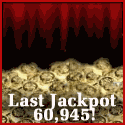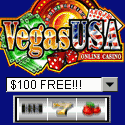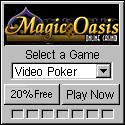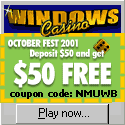Play
To Win
Tips and strategies to help make you a winning casino player Game
Rules
Learn: Blackjack, Baccarat, Craps, Roulette, Slots, Video Poker, Pai Gow Poker
Systems Gallery
Win more, more often with proven betting methods from the systems gallery
Order
Form
A secure on-line order form to purchase products advertised by Let's Talk
Winning.
Playing Online
All about gambling at online casinos. Find out where the best deals are
Links
and Things
Sign our guestbook, refer a friend, link to other gambling sites
Newsletter
Click above to read the current edition of our
weekly newsletter. Then get your own free subscription right here. Enter your e-mail
address for immediate delivery of an introductory issue, including a FREE ROULETTE SYSTEM:
Please tell all
your friends about it.
On-Line Forum
Post a gambling question or opinion - get an
answer . . .

 Wanna Win At Slots? Click
Here! Wanna Win At Slots? Click
Here!






It's now $50 bonus every month!








|
=========================================
Thursday, February 21, 2002
Feedback on The Derivative Method - Blackjack Tips - TTS Q and A
Hello
everyone,
The Derivative Method published in the last newsletter drew the attention of many.
One of the
customers (Tony) gives the following feedback:
"Hello Izak,
I really enjoyed your newsletter on the derivative method. Being a craps player I read
something in the Gambling Times magazine 25 years ago that interested me. It said to bet
that 4 consecutive shooters can't make 3 passes in a row. I tested this out in the 25,000
craps decisions and 72 hours at the crap table. It never did lose but it did get to the
12th bet a few times. I t didn't mention the betting amounts so I just used the Martingale
but of course if I were to play this for real money I would chicken out way before the
12th bet. It sounds as if the derivative method would be perfect for this method.
In the article you would stop betting against the shooter if he wins 3 in a row and
wait until he 7s out to start betting again. I'll have to reread the derivative method
again to see how it would work with this method. I will go back and check the distance
between the failing points.I wrote down but can't find the paper on how many times it
reached the 2nd, 3rd and 4th levels and how many wins between the failing points.
Thanks, Tony"
And after going back and
checking some points, Tony comes back with the following 2 comments:
"Hello Izak,
I really like your thinking on the derivative method. I went back to check some craps
results to see how many wins between failing points and these are the results for
500 dec.
(4,14,5,29.4,lose,1,12,3,9,10,14,7,3,lose,14,7,7,2,22,5,4,9,2,1,lose,lose,2,22,4.). If I
were to try for 2 wins after losing a series of 7 units(Bet 1-2-4), I would make 10 units
in those first 5 series and then lose 7, now when I won the 1 bet then lost a series I
would lose only 6 units because of that first win, I believe. Then I would win 14 units on
the next 7 series, then a loss of 7, then a win of 18, then a loss of 6 and then a loss of
14 on a series that saw back to back losses and then a win of 6 for a total
win of 8 units. If trying for 3 wins I think the profit would be 8 units also. If trying
for 4 wins the profit would be 13 units if I did it right. I really like this derivative
method a lot. The craps method was to play the don't pass and bet against the
shooter making 3 passes in a row.. If you lose 3 bets you stop betting and wait for the
shooter to 7 out and then bet against the next shooter making 3 passes. Do this for
4 consecutive shooters. I never knew what to do with my findings until I read your
Derivative method, I like it very much. Thanks, Tony."
"Hi Izak,
Want to say thank you again for the derivative method. What it does is make you miss (not
lose) a failing point which cuts down on the losses than if you were to bet all the time
with no interruption. I took page 31 of the craps booklet where it lost 42 units using a
1-2-4 dont bet progression without stopping. Using failure points as a base for stopping
if trying to win 2 units I would have made 8 units, 3 wins made 11 units, 4 wins would of
lost 6 units because most of the failure points were less than 4. Out of 34 failure points
there were 10 that were 3 or less . What I am doing is finding how many wins between
failure points and then seeing how many wins to shoot for. With this little testing done
so far 2 seems to be a safe number. If you shoot for a higher number you can win
more but you could lose more if total wins between failure points are small in number.
I just wanted to point out that this method is the closest thing I have seen to
work in a negative game.
Thanks again, Tony"
"That derivative
method is something else! What a great concept! I can see how this would help
me immensely in the casinos. By determining the loss points and wins, and only
playing after loss points, would surely increase my winnings. I love this
thing! John"
Indeed, you
can combine the concept of the Derivative Method with your betting selections and
progressions to cut down on your losses tremendously.
I thank you
all for your feedback.
Blackjack Tips
What do you do when the dealer has a 2?
When the dealer has a 5 or 6 showing, the
player has, basically, a very easy decision to make. If you've got a bad hand, you stand,
banking on the hope that the dealer will bust. If you've got a good hand, depending on the
nature of the hand, you will stand (if you are pat), double, or split. The 5 and 6 are the
worst upcards the dealer can have, and if the opportunity presents itself, you have to get
as much money on the table as possible to take advantage of your position.
But how do you approach the situation if the dealer has a two showing? Standard rules of
the Basic Strategy dictate that there are two sides to the hitting/standing decision chart
- the "low" cards (2 through 6) and the "high" cards (7 through Ace).
An imaginary line is drawn between these two groups; for example, with those hands
commonly known as "stiff" hands 12 through 16) you would usually hit against the
high cards, and stand against the low cards. There is also no soft doubling against the
high upcards.
There is one notable exception, however, and that is when the dealer is holding a two on
top. The two is indeed in the "low card" group, but because it is the lowest of
the low, it is the hardest to play against. A dealer with a five showing will bust 43% of
the time, and with a six it will happen only 42% of the time. When a dealer has a two as
his upcard, he will bust only 35% of his hands. Now the difference may not seem like a
lot, but it really is when taken in this context - when we conceive theory in the game we
speak in terms of how much each strategy decision will work out in the LONG run, since, of
course, anything can happen in the SHORT run. Looking at it this way, the seven or eight
less breaks per hundred hands add up big time over the course of a great many hands. It is
a pain fact that the dealer with a two on top will usually have to draw two ten-value
cards to bust out; anything less and the chances are great that his hand will be pat.
The strongest dealer upcards, in order, are the Ace, ten-value cards, nine, eight, and
seven. Next in line is the two, and it is in fact such a respected and feared upcard that
many count systems do not even include the two as a low card for the purposes of
determining the plus-minus value of cards, preferring to leave it neutral instead, along
with the 7,8, and often times, the 9 ("neutral" meaning, of course, that it is
of equal value to both player and dealer).
To deal with the relative strength of the two, some subtle exceptions in the Basic
Strategy are, of course, in order. For instance, when presented with a 12 against the
dealer's two, the player will always take one hit. This play is also appropriate when the
player has a three, by the way. Remember to take ONLY ONE HIT in this situation, though.
Any denomination, even the lowest value (an Ace) would add up to at least 13, and, when
this three-card is plugged into the Basic Strategy, the correct move is to stand against
stiff upcards.
Also, the player's nine is doubled on the 3 through 6 upcards, but not against the two,
however, because the nine is simply not a strong enough hand to make it mathematically
feasible. And please - never, EVER double any soft hand against the dealer's two. Let a
signal go off in your head when this situation arises.
Practice and learn how to deal with a dealer's upcard of two. It may be a small card, but
can figure BIG in some important decisions if not played correctly.
Interest on Edmond Petitjean's TTS (Trade Tuner System) keeps growing. Edmond answers some more
questions this week:
Q: I have read all
your write-up and FAQs on it, but there's one thing you simply overlooked to explain: is
this a software? I assume it is a software that generates charts, among other things,
because you said, "With TTS, you'll see a very clear screen before your
eyes...". If it is a software, one must need a computer to use it, right?
Another question: if I buy TTS, how will I select the right stock or option to trade,
among the thousands that are out there in Wallstreet?
Thanks, will really appreciate some more info on TTS.
A: TTS is not a software
package, it is a course that can be sent through e-mail.
When I speak of graphs, it is because you can use nearly every trading program or even
graphs that are available on the internet. TTS is not dependend on any specific
software. All this is fully explained in this course.
About selections: you can use lots of screening systems that are offered on the internet
(the one of Microsoft is even free).
It is also not necessary to follow 1000 stocks: you can use a few that you follow closely
(good movers with high volume) and trade only those. Or you could follow a couple -
or even only one - indexes (example: sp500).
If the sp500 is too expensive, you can choose the e-mini version. The main thing to
keep in mind with TTS is exactly not to create an over-input of information, which only
creates overload and poor efficiency.
The goal of TTS is to make things simple and profitable at the same time.
Q: How many trades will I
get if for example I was daytrading 5 minute bars on the sp500? or 15 minute bars? What
will be the approximate accuracy?
I would love to start daytrading again as soon as I can build up my capital.
A: If you trade 5 minutes
bars you'll get about 2 to 4 trades a day and with 15 minutes bars it will be 1 or 2.
The accuracy is extremely high (80-90%).
Q: Thank you for the extra
consideration of executing those T-Bond option trades. I have never traded options, but
would learned to if TTS works best with them and I bought the system. I have only traded
futures and am now daytrading the Emini S&P 500 and Emini Nasdaq. Does it work on
futures, and is it mainly a pattern recognition system or does it use indicators?
A: I bought put options on
the T-Bonds and A COUPLE OF HOURS LATER I sold them for a profit of 89%!!!
Who can do better?
This illustrates the awfull power of TTS.
You can also trade futures or anything else, TTS doesn't care.
But I prefer options, because the risk in totally in control and you cannot be whipsawed
that easily.
Don't worry if you don't have any experience with options, because I'll guide you when you
buy TTS.
Q: Hello Sir,
I am very interested in TTS. Can you answer me a few questions please?
I daytrade the S&P500 and also trade stocks on a short term basis (3-10 days) and was
wondering if you could supply some stats on these markets for me. ie. profitability,
accuracy, number of trades per month etc......
Whatever you could do would be wonderful as you sound like a guy that has been through the
trading trenches and buying systems blues as I have. It's a pleasure to always talk to
someone who has been in the same field and has had the same frustrations.
A: Your time frame is also
mine: I prefer to trade in this same range, mainly because I trade options on the
Amsterdam market most of the time.
Don't get scared by terrribly complex 5 leg options constructions, because you'll never
need them when using TTS. Only those that have no clue about the next move of the
market need these things.
TTS is that good, that simply doing open buys and closing sells only is more than enough
to be an absolute winner (so your risk is also always predetermined with precision and you
can soundly sleep at night and you aren't bothered by whipsawing).
My system is FAR superior to most other approaches because of its beautiful simplicity,
clarity and profitability.
Besides the fact that selling my system will help me to get a bigger trading capital in a
shorter time span - allowing me to take bigger positions - it's also a very positive
feeling to get others out of the dark.
When buying TTS you won't be left on your own neither: you can always reach me by e-mail (edmond.petitjean@skynet.be) when in doubt
about something and people know that I'm always answering very quickly.
Included is a full year sp500 (a test I did in 1997). I'm not trading the sp500 myself,
but there is no difference in what you trade, be it stocks, options, warrants, futures on
commodities, forex,...
TTS is also indifferent to the time frame you prefer: it could be 1 minute bars up to 1
month bars.
You can use whatever software you have or even straight on the internet (where you can
find all graphs you need).
I have a special offer to customers that buy before the end of February:
I discovered recently a very strange aspect of all markets: each year there are
specific and fixed dates where all markets turn. I know why this is so and I will give you
the dates upon the purchase of the course. Yes, THOSE ARE THE EXACT DATES
THAT MOST MARKETS WILL TURN FOR A FULL YEAR!
Click to order.
Thank you, Edmond Petitjean
Be sure to stay tuned next week, as a
superb Craps system will be announced. It beats the Zumma crap tester book in its
entirety and it beats Crapshoot, another crap system tester by Huey Mahl with 53,706 rolls
of dice. It's a real long-term winner. Look for the keyword: "Key
System".
Wishing you
all the best,
Until next week,
Izak
| WOULD YOU LIKE
TO SUBSCRIBE? |
 |
If you missed any
newsletter, click here for an archive.

|
 Let's Talk Winning
Let's Talk Winning